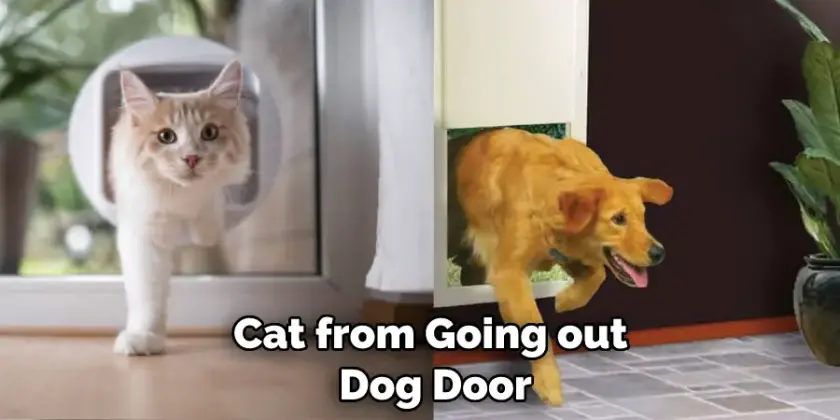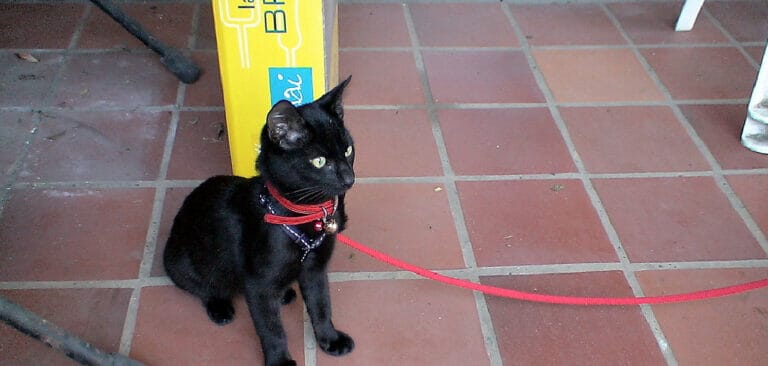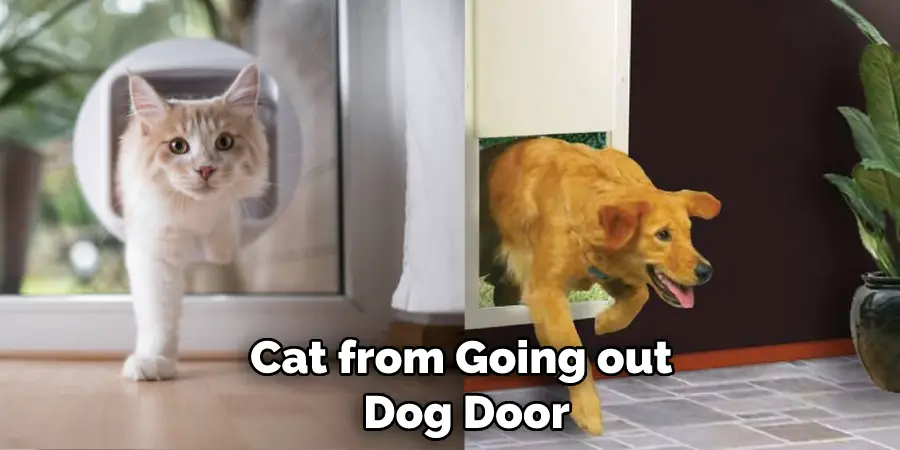Are you tired of your cat constantly sneaking out through the dog door?
Fortunately, there are effective ways to keep your feline friend indoors. By implementing a few simple strategies, you can ensure that your cat stays safely inside while still allowing your dog to use the door freely.
Let’s explore some practical methods to keep your cat from going out the dog door and provide them with a secure and comfortable environment.
One of the easiest solutions is to install a cat door alongside the existing dog door. This way, your cat can have its own entrance that is too small for your dog to use. A cat door allows your feline companion to come and go as they please without risking their safety or venturing into unknown territory. Another option is to consider installing an electronic dog door that can be programmed to respond only to a special collar worn by your dog. By setting the activation range to a size that is too large for your cat, you can effectively keep them from accessing the door. This gives your dog the freedom to come and go while keeping your cat safely indoors. If installing a separate door is not possible or practical, you can create a barrier that blocks your cat's access to the dog door. This can be achieved by using a baby gate, a temporary fence, or even a piece of furniture strategically placed in front of the opening. Ensure that the barrier is tall enough to prevent your cat from jumping over it.

Cat-Proofing Techniques for Your Dog Door
If you have both a cat and a dog at home, you know how challenging it can be to keep them separated. One common area of concern is the dog door. While it offers convenient access for your furry friend, it can also become an entry point for your curious cat. To ensure the safety of both your pets and maintain their individual boundaries, here are some effective cat-proofing techniques for your dog door.
1. Install a Cat-Proof Barrier
The first step to cat-proofing your dog door is to install a barrier. This can be a physical obstruction that is too difficult for your cat to overcome while allowing your dog to easily pass through.
One option is to use an adjustable gate or pet gate designed specifically to keep cats out.
These gates typically have gaps or mesh panels that cats cannot squeeze through, while still allowing dogs to pass freely.
2. Add a Cat Door
If your cat is persistent in accessing the dog door, consider adding a cat door next to or above the dog door.
Cat doors are smaller in size and have flaps designed for cats to comfortably go in and out.
By providing a separate entrance for your cat, you can control their access without compromising your dog’s freedom.
3. Use Electronic Collars
Electronic collars can be a useful tool in cat-proofing your dog door. These collars work in conjunction with the dog door, allowing only pets wearing the collar to pass through.
The collar emits a signal that triggers the door to unlock, preventing cats without the collar from gaining access.
This ensures that only your dog can use the door while keeping your cat out.
4. Create a Cat-Friendly Space Indoors
To discourage your cat from attempting to use the dog door, create a cat-friendly space indoors where they can feel comfortable and have their own designated area.
This can include a cozy bed, scratching post, toys, and access to food and water. By providing an enticing indoor environment, your cat may be less inclined to venture outside through the dog door.
5. Modify the Dog Door
If your dog door has a larger opening that allows cats to pass through, consider modifying it to make it cat-proof.
One option is to install a smaller flap or add a threshold that requires more effort for a cat to pass.
You can also attach magnets to the door that repel cats but have no effect on your dog. These modifications can effectively deter your cat from attempting to use the dog door.
6. Use Motion-Activated Sprays
Motion-activated sprays can also be an effective deterrent for cats trying to access the dog door.
These sprays emit a burst of air or a harmless spray when triggered by motion, deterring cats from getting close to the door.
Place the spray near the dog door, ensuring that it covers the area where a cat would typically approach. This can discourage your cat from approaching the door altogether.
7. Use Visual Deterrents
Make the dog door less appealing to your cat by using visual deterrents. Place sticky tape or aluminum foil around the edges of the door, as cats dislike the texture.
You can also hang a curtain or create a barrier using a baby gate to physically block access to the dog door.
These visual cues will discourage your cat from attempting to go through the door.
8. Positive Reinforcement
Positive reinforcement is essential in training your cat to stay away from the dog door.
Whenever your cat avoids the door or uses their designated cat door instead, reward them with treats, affection, or playtime.
By associating good behavior with rewards, your cat will be motivated to repeat the desired action.
9. Supervise and Redirect
Keep a close eye on your cat and supervise their behavior around the dog door. If you notice them approaching the door, gently redirect their attention to another activity or area of the house.
This will help break the habit of using the dog door and reinforce the idea that their designated cat door is the proper way to go in and out.
10. Seek Professional Help
If cat-proofing techniques alone aren’t sufficient, consider seeking professional help. A pet behaviorist or trainer can provide personalized advice and guidance on how to address the specific challenges you are facing with your cat and dog.
They can help you implement effective strategies to prevent your cat from accessing the dog door and ensure the safety and harmony of your pets.
In summary, cat-proofing your dog door is essential for maintaining the safety and boundaries of your pets. By implementing these techniques, you can create a pet-friendly environment that allows your dog to use the door freely while preventing your curious cat from getting into potentially dangerous situations. Remember to choose the method that best suits your needs and consult with professionals if needed. With these cat-proofing techniques in place, you can enjoy peace of mind knowing that your pets are safe and secure.

Are there any other options to keep my cat indoors?
Yes, if installing a cat door is not feasible, you can create a designated indoor area for your cat by setting up a cat room or using cat gates to restrict access to certain parts of the house. Providing stimulating toys, scratching posts, and regular playtime can also help keep your cat entertained and reduce the desire to go outside.
My cat keeps escaping despite my efforts. What else can I do?
If your cat is persistent in trying to go outside, it may be worth considering harness training. By teaching your cat to walk on a leash, you can safely take them outside under your supervision. This allows your cat to satisfy its curiosity while ensuring its safety. Make sure to use a cat-specific harness and leash, as regular dog equipment may be too bulky or uncomfortable for cats.
How do you train a cat to go outside and not run away?
To train a cat to go outside without running away, follow these steps:
- Use a leash and harness to introduce outdoor exploration gradually.
- Supervise outdoor time initially and gradually increase it.
- Train your cat to come when called using treats and positive reinforcement.
- Ensure your outdoor area is secure, with no escape routes.
How do you train a cat to stay indoors?
Training a cat to stay indoors involves:
- Providing engaging indoor activities like toys and scratching posts.
- Creating a comfortable indoor environment.
- Using positive reinforcement for staying inside.
- Gradually reducing outdoor access if necessary.
What smell do cats hate outside?
Cats dislike certain odors, including citrus, menthol, and strong herbal scents like lavender and rosemary. These can be used as natural deterrents around outdoor areas.
What smell do cats hate the most?
The scent that most cats strongly dislike is citrus. You can use citrus-scented sprays or peelings to deter them from specific areas.
How do I keep animals out of my dog’s door?
To keep other animals out of your dog’s door, consider:
- Installing a pet-specific door with advanced locking mechanisms.
- Using electronic doors that respond to your pet’s collar tag.
- Setting up motion-activated deterrents near the door to discourage intruders.
Are cats afraid of closed doors?
Cats generally prefer open spaces and may become curious about closed doors. However, their reaction can vary from cat to cat. Some cats may scratch at closed doors, while others may simply ignore them.
Are dog doors a good idea?
Dog doors can be a great convenience for dog owners, allowing pets to come and go as needed. However, they can also pose security and safety risks if not properly managed. Consider your specific situation, the size of your dog, and potential intruders when deciding if a dog door is a good idea for your home.
Conclusion
Keeping your cat from going out of the dog door is essential for their safety and your peace of mind.
By implementing a few strategies, you can effectively prevent your cat from accessing the dog door.
Installing a cat-specific door with a microchip sensor or collar tag can restrict access only to your cat, while keeping the dog door accessible for your dog. Alternatively, you can use a barrier like a baby gate or create a separate area for your cat to prevent them from reaching the dog door.
Consistently reinforcing training and providing plenty of enrichment indoors will also help to discourage your cat from attempting to escape through the dog door.
Remember, each cat is unique, and it may take some time and patience to find the best solution that works for your feline friend. By prioritizing their safety and providing alternative outlets for their energy and curiosity, you can help them stay safe inside while still allowing your dog the freedom to use the dog door.


